Reflection of Light
Maharashtra Board-Class 9-Science & Technology-Chapter-11
Solution
|
Topics to be learn :
|
Light : Electromagnetic radiation in the wavelength range 4x10-7m to 7x10-7m, when incident on the eye, allows us to see the objects around us. This radiation is called light.
Reflection of light : When light is incident on the surface ofan object, in general, it is deflected in different directions. This process is called reflection of light.
- Reflection of light from a smooth, flat surface is regular reflection
- Reflection of light from a rough surface is irregular reflection.
Mirror : A mirror is a surface which reflects light and produces a clear image.
| The German scientist Justus von Liebig coated the plane surface of a piece of ordinary glass with silver metal and made the first mirror. Such a mirror is called a silvered glass mirror. |
Plane mirror - A mirror is made by coating the back surface of a flat and smooth glass piece with a thin, reflecting film of aluminium or silver. To protect this reflecting film and to make that side opaque, another coat of a substance like lead oxide is given over it.
The characteristics of the image formed by a plane mirror :
- The image is virtual.
- The image is of the same size as that of the object.
- The image is erect.
- There is lateral inversion, i.e. the left side and the right side are interchanged.
- The image is as far behind the mirror as the object is in front of the mirror.
Therefore if we hold a page of a book in front of a mirror, we see laterally inverted letters in the mirror. Lateral inversion is essentially the result of image formation according to the laws of reflection.
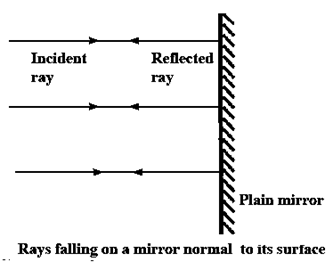
Laws of reflection of light :
- The incident ray and the reflected ray of light are on the opposite sides of the normal to the reflecting surface at the point of incidence and all the three are in the same plane.
- The angle of incidence and the angle of reflection are equal in measure.
Q. Show that in order to see the full image of a person standing in front of a plane mirror, the minimum height of the mirror must be half the height of the person.
Ans. In Fig. HF represents the person standing in front of a plane mirror PQ and HF represents his image.

Points H, E and F correspond to the top of the head, eyes and the feet of the person respectively.
R is the midpoint of HE and S is the midpoint of EF.
PQ is parallel to HF. From the figure, the minimum height of the mirror, PQ, kept at a height QN from the ground, is :
PQ = RS = RE + ES = HE/2 + EF/2 = HF/2 = half of the height of the person.
Spherical mirrors :
- Concave mirror : A spherical mirror with its inner side (inner surface or concave surface) polished (and hence reflecting) is called a concave mirror. OR If the inner surface is the reflecting surface, it is a concave mirror.
- Convex mirror : A spherical mirror with its outer side (outer surface or convex surface) polished (and hence reflecting) is called a convex mirror. OR If the outer surface is the reflecting surface, it is a convex mirror.
| Place two plane mirrors at an angle of 900 to each other. Place a small object between them. Images will be formed in both mirrors. No images formed in the mirror can be calculated by below formulae
n = , n = number of images, A = angle between the mirrors. Example For A = 120° n = \(\frac{360}{120}-1\) = 2, For angle 120° , 2 images will be formed. Example For A = 90° n = \(\frac{360}{90}-1\) = 3, For angle 90°, 3 images will be formed
|
Terms related to spherical mirrors :
Pole : The centre of the mirror surface is called its pole.
Centre of curvature : The centre of the sphere of which the mirror is a part, is called the centre of curvature of the mirror.
Radius of curvature : The radius of the sphere of which the mirror is a part, is called the radius of curvature of the mirror.
Principal axis : The straight line passing through the pole and centre of curvature of a spherical mirror is called its principal axis.
Principal focus :
- Incident rays which are parallel to the principal axis of a concave mirror, after reflection from the mirror, meet at a particular point in front of the mirror on the principal axis. This point is called the principal focus of the concave mirror.
- In the case of a convex mirror incident rays parallel to the principal axis, after reflection, appear to come from a particular point behind the mirror lying along the principal axis. This point is called the principal focus of the convex mirror.
Focal length : The distance between the pole and the principal focus of a spherical mirror is called the focal length of the mirror.
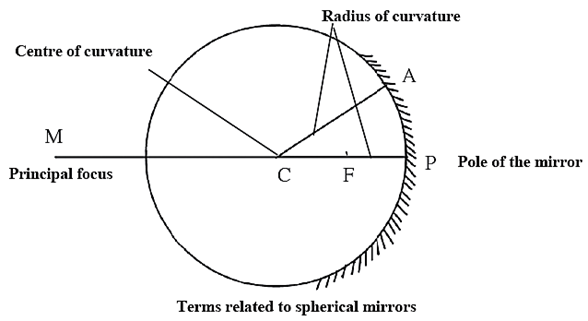
Images formed by spherical mirrors : Rules for drawing a ray diagram.
(1) If an incident ray is parallel to the principal axis then the reflected ray passes through the principal focus.
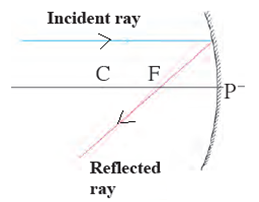
(2) i. If an incident ray passes through the principal focus of a concave mirror, the reflected ray is parallel to the principal axis.
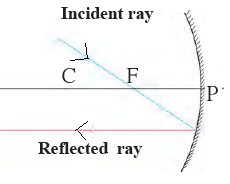
(2) ii. If an incident ray is directed towards the principal focus of a convex mirror, the reflected ray is parallel to the principal axis.
(3) i. If an incident ray passes through the centre of curvature of a concave mirror, the reflected ray traces the same path back.
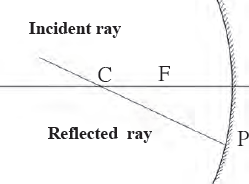
(3) ii. If an incident ray is directed towards the centre of curvature of a convex mirror, the reflected ray traces the same path back.
Images formed by a concave mirror :
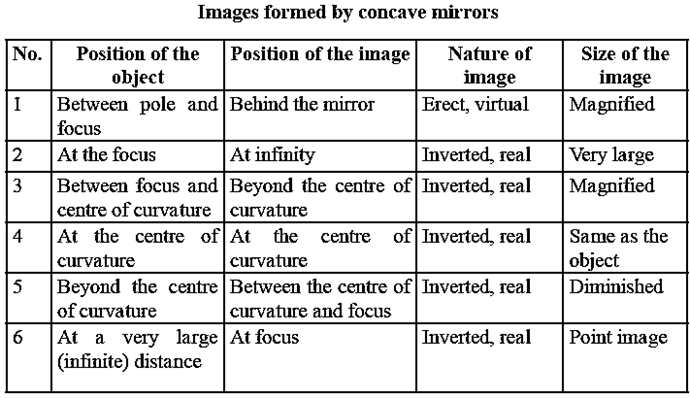
Image formed by a convex mirror: It is always behind the mirror, erect, virtual and diminished.
Mirror formula : The relationship between the object distance (u) image distance (v)) and focal length (f) of a spherical mirror is called the mirror formulae and is given as.
\(\frac{1}{u}+\frac{1}{v}=\frac{1}{f}\)
Sign convention for reflection of light by a spherical mirror :
According to the Cartesian sign convention, the pole (P) of a spherical mirror is taken as the origin and the principal axis is taken as the X-axis of the frame of reference.
- The object is always placed on the left of the mirror. All distances parallel to the principal axis are measured from the pole of the mirror.
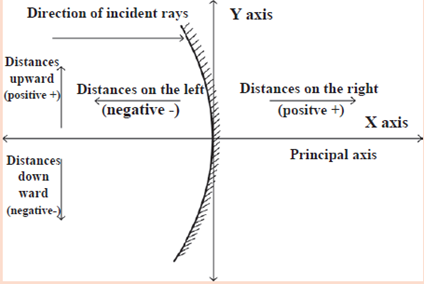
Fig-Cartesian sign convention
- All distances measured to the right of the origin (pole) are taken as positive while distances measured to the left of the origin (pole) are taken as negative.
- Distances measured vertically upwards from the principal axis are taken as positive.
- Distances measured vertically downwards from the principal axis are taken as negative.
- The focal length of a convex mirror is positive while that of a concave mirror is negative.
Magnification by a spherical mirror:
Magnification (M) produced by a spherical mirror
= \(\frac{\text{height of image}(h_2)}{\text{height of the object}(h_1)}= -\frac{v}{u}\)
As the object is always kept above the principal axis, its height is always taken to be positive. For virtual images, the height is positive while for real images, it is negative. As the object is kept on the left of the mirror, its distance (u) is always negative.
Uses of a concave mirror :
A concave mirror is used in search-lights, in headlamps, for shaving, for examining the teeth by a dentist, etc.
- Barber shop, dental hospital – If the object is placed between the pole and focus of the mirror, an erect, virtual and magnified image is obtained
- Torch and head lamps of vehicles- The source of light is kept at the focus of the mirror. Thus, a parallel beam of light is obtained.
- Flood lights- The source of light is placed a little beyond the centre of curvature of the mirror. This gives a bright beam of light.
- Various equipment using solar energy - Sun rays reflected by a concave mirror come together in the focal plane.
Uses of a convex mirror :
- A convex mirror is used as a rear-view mirror in a four-wheeler, motorcycle, etc.
- Big convex mirrors are fitted in shops.
Convergence of light : When light rays meet at a single point, it is called convergence of light.
- Uses : A converging beam of light is used by doctors to examine teeth, ears, eyes, etc. It is also used in solar devices.
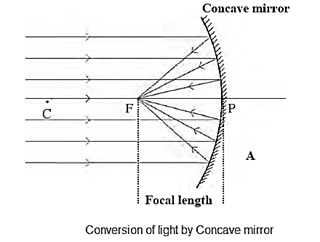
Divergence of light : Ans. When light rays from the same point source spread away from each other, it is called divergence of light.
- Uses : A diverging beam of light is used in streetlights and table lamps.

| The image in front of the mirror which can be obtained on a screen is called a real image. For any position of the object, a convex mirror always produces an erect diminished image (which is smaller than the object) and is situated behind the mirror.
The image which is behind the mirror and thus cannot be obtained on a screen is called a virtual image. The magnification of such an image is less than 1. |
Periscope :

The two mirrors in a periscope are placed parallel to each other so that the rays of light emerging out of the periscope are parallel to the rays incident on the top window of the periscope and hence the location of the object can be seen clearly. See Fig.
- A periscope is used on a submarine to keep a watch on things above the surface of the sea even when the submarine is under water.
Kaleidoscope : In a kaleidoscope, three plane mirrors are fixed at 60° with each other. Hence, the rays of light starting from an object (reflected rays) are reflected many times by the mirrors, thereby forming many images.
Useful links :
| Main Page : - Maharashtra Board Class 9th Science & Technology - All chapters notes, solutions, videos, test, pdf.
Previous Chapter : Chapter 10: Information Communication Technology - online Notes Next Chapter : Chapter 12: Study of Sound - online Notes |
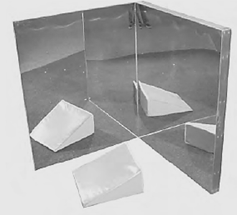
This academi give very easy and good notes.the language of notes is quickly understood.I like this academi.but their are one problem that is the sequence.the sequence of notes and the book is missMatch so that I confused 🤔 please give notes by sequence of book 📚📚📖 others are all good 😊🤗
Please try to give sequencely
Thanks for your valuable suggestions. We have noted this and already started to work on it.
It was very best link,get any types of ideas and thinkings and any sub we can learn it link also above information we can give use for mind
This is very important notes 🙏🙏
I ordered 10 notes from this website for my school exam and it get very helpful for me